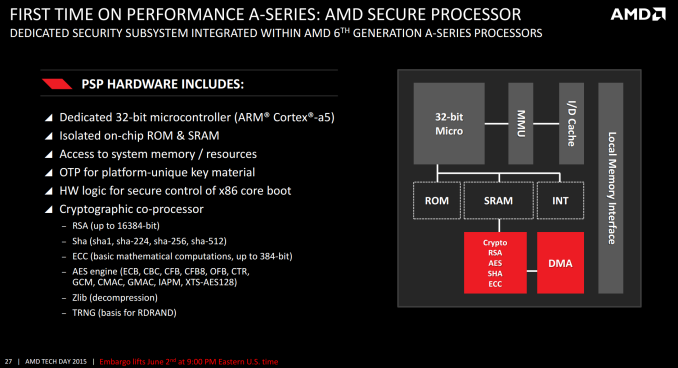AMD Launches Carrizo: The Laptop Leap of Efficiency and Architecture Updates
by Ian Cutress on June 2, 2015 9:00 PM ESTAMD Secure Processor
One of the final pieces in the puzzle is AMD’s Secure Processor, which they seemed to have called the PSP. The concept of the security processor has evolved over time, but the premise of a locked down area to perform sensitive work that is both hidden and cryptographically sealed appeals to a particular element of the population, particularly when it comes to business.
AMD’s PSP is based around a single 32-bit ARM Cortex-A5, with its own isolated ROM and SRAM but has access to system memory and resources. It contains logic to deal with the x86 POST process but also features a cryptographic co-processor.
ARM has been promoting TrustZone for a couple of years now, and AMD has been tinkering with their Secure Processor proposition for almost as long although relatively few explanations from AMD outside ‘it is there’ have come forward.
Final Thoughts
Sometimes a name can inspire change. Carrizo isn’t one of those names, and when hearing the words ‘AMD’s notebook processor’, those words have not instilled much hope in the past, much to AMD’s chagrin no doubt. Despite this, we come away from Carrizo with a significantly positive impression because this feels more than just another Bulldozer-based update.
If you can say in a sentence ‘more performance, less power and less die area’, it almost sounds like a holy trifecta of goals a processor designer can only hope to accomplish. Normally a processor engineer is all about performance, so it takes an adjustment in thinking to focus more so on power, but AMD is promising this with Carrizo. Part of this will be down to the effectiveness of the high density libraries (which according to the slides should also mean less power or more performance for less die area) but also the implementation of the higher bandwidth encoder, new video playback pathway and optimization of power through the frequency planes. Doubling the L1 data cache for no loss in latency will have definite impacts to IPC, as well as the better prefetch and branch prediction.
Technically, on paper, all the blocks in play look exciting and every little margin can help AMD build a better APU. It merely requires validation of the results we have been presented along with a killer device to go along with it, something which AMD has lacked in the past and reviewers have had trouble getting their hands on. We are in discussions with AMD to get the sufficient tools to test independently a number of the claims, and to see if AMD’s Carrizo has potential.











137 Comments
View All Comments
FlushedBubblyJock - Tuesday, June 9, 2015 - link
they probably have their contrast off, clear type disabled, the wrong screen font, smoothing edges of fonts disabled, then he's probably a far sighted coke bottled glasses with bifocals... thus amd must be had in dooper high rezz at 14fps...meacupla - Wednesday, June 3, 2015 - link
Ideally, what you'd get is a 2560x1440 screen with PROPER scaling to 1280x720, unlike what most monitors seem to do, which is a terrible job at scaling.SilthDraeth - Wednesday, June 3, 2015 - link
I run a Kaveri on my desktop and it drives 1080p just fine. Anyways, most intel laptops in that same range run 1366x768 screens also. At least almost every laptop you find in a Staples, or a Walmart. Very few of the devices on display have a higher resolution screen, or IPS solution.yankeeDDL - Wednesday, June 3, 2015 - link
Yes, *and* Intel's in that price range don't run games.FlushedBubblyJock - Tuesday, June 9, 2015 - link
yes they do make sure you have hd3000 at least but that's cheap as beansMargalus - Wednesday, June 3, 2015 - link
how is it an "issue that plagues AMD"? Are you saying AMD chips are buggy and crash at that resolution? Are you saying AMD graphics get corrupted at that resolution?medi03 - Thursday, June 4, 2015 - link
Ditto.In fact, 1366x768 TN (!!!) screen is the main issue with AMD mobile chips.
Drumsticks - Wednesday, June 3, 2015 - link
The 45W A8-6500T scores 71 in Cinebench R15. Even assuming that 15W kaveri gets identical performance (I couldn't think of a 15w kaveri chip to check on bench) that puts it at 106, which is finally, finally even with broad well in the xps 13, or at least <10%.Skylake will probably add another 10% gap, but this is the closest AMD might be in the last seven years or so to catching up with Intel. And at half the price, they could seriously have the start of a comeback!
xenol - Wednesday, June 3, 2015 - link
My only problem with AMD and the marketing blurbs is that they're targeting niche markets for all intents and purposes. Despite what PC gamers want us to think how big PC gaming is, it's not exactly a majority player in the entire scheme of things and gaming on a laptop isn't really that accepted.And even if gaming is involved, it's usually not games that require beefy specs to begin with.
Michael Bay - Wednesday, June 3, 2015 - link
PC gaming by marketshare is on par with any pastgen/nextgen console and sometimes more than one.